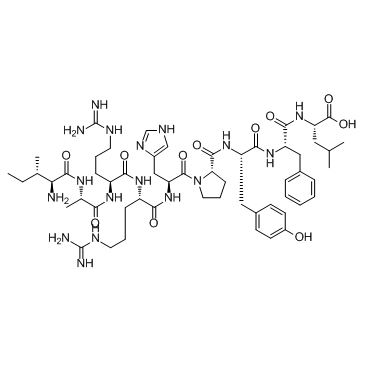| Description |
Kinetensin is a neurotensin-like peptide isolated from pepsin-treated human plasma.
|
| Related Catalog |
|
| Target |
Neurotensin Receptor[1]
|
| In Vitro |
The peptide kinetensin isolated from pepsin-treated human plasma induces a dose-dependent release of histamine when exposed to rat peritoneal mast cells. The threshold concentration is around 1 μM, the ED50 is 10 μM, and the optimal concentration of between 100 to 1000 μM released 80% of the total histamine. Kinetensin is 10 to 100 times less potent than neurotensin and equipotent with the opioid peptide dynorphin. The histamine release is clearly temperature-dependent, with no release occurring at 0 or 45 °C and with an optimum around 37 °C. The histamine release is significantly reduced in the absence of extracellular calcium[2].
|
| In Vivo |
Kinetensin also induces a dose-dependent increase in vascular permeability when injected intradermally into rats[2].
|
| Cell Assay |
Rat peritoneal mast cells are incubated with kinetensin at 37°C for 10 min. The incubation is stopped by the addition of 1.8 mL of ice-cold buffered saline and cells are separated from supernatant by centrifugation. Histamine release is expressed as per cent of total mast cell histamine[2].
|
| Animal Admin |
Rats[2] Anesthetized Sprague-Dawley rats are given 25I-albumin i.v. Samples are then injected intradermally in 5x2 spots on the back and comprised saline as a control or kinetensin in different doses in 100 μL saline. After 20 rain, skin biopsies of 7 mm diameter are cut out, weighed and transferred to a gamma-counter. Results are expressed as: (counts per min (cpm) in tissue per gram wet weight/cpm in plasma per mL plasma)[2].
|
| References |
[1]. Mogard MH, et al. The amino acid sequence of kinetensin, a novel peptide isolated from pepsin-treated human plasma: homology with human serum albumin, neurotensin and angiotensin. Biochem Biophys Res Commun. 1986 May 14;136(3):983-8. [2]. Sydbom A, et al. Stimulation of histamine release by the peptide kinetensin. Agents Actions. 1989 Apr;27(1-2):68-71.
|


